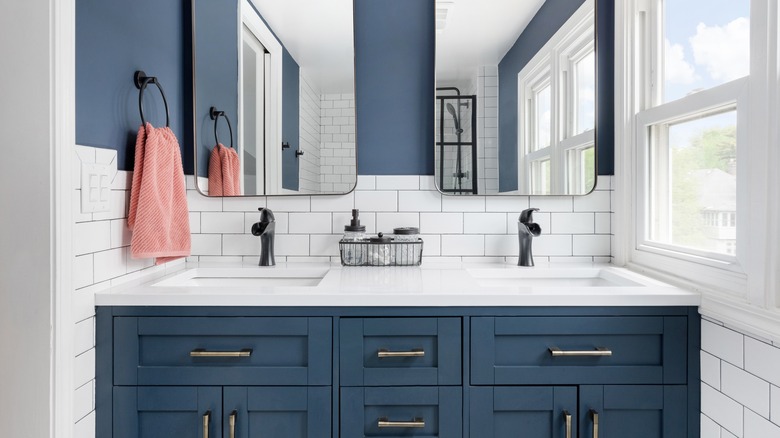These Are The Sheens You Should Use When Painting Bathroom Cabinets
A fresh coat of paint can make your bathroom feel brand new. However, painting a bathroom, specifically the cabinets, presents more of a challenge than this task does in other rooms of the home. Because of the moisture produced by the shower, bathrooms tend to be more humid areas, so choosing the right materials is essential. You want a paint that is moisture-resistant against splashes and water drops on top of being a durable option for the vanity. That's why you should opt for a higher-gloss finish in this room. Using a satin or gloss sheen protects the surface better than flat and eggshell finishes from moisture while also making the surface easier to clean.
Glossy finishes may also be a good option for smaller bathrooms because of their ability to reflect light. They can act like a mirror and bounce natural or artificial light around the room, helping the space appear brighter and larger. However, glossier finishes show imperfections in the surface more than lower-gloss finishes. So, if you have older cabinetry with knicks and scratches already, you may want to consider sanding or replacing the cabinets before painting to achieve a smooth finish. There are also primers that help prevent the growth of mold and mildew, so it's a good idea to use these before painting in humid areas like the bathroom as well.
Why you should choose glossy finishes
There are major benefits to using glossy paints and finishes in humid rooms like the bathroom. Since the glossy layer creates a protective seal, it's much more difficult for moisture to get between the paint layers. This protects the paint from peeling and bubbling off of the cabinets, even when exposed to repeated humidity or water. The coating creates a protection that stands up to knicks and scratches in the paint, which is ideal for busy families that may see a lot of traffic and possible wear and tear in this space. And while the paint itself doesn't prevent mold and mildew growth, higher-glosses do better at keeping out the moisture that's the cause of this growth compared to flat and eggshell finishes.
Glossier finishes are also much easier to clean. The protective layer keeps shampoo, water, and other potential splashes from seeping deeper into the paint. They can be wiped down with ease and leave little staining, so you don't have to worry about toothpaste splashes or soap residue sticking around. The slick layer also makes a much easier surface to wipe down with a damp cloth and soap. The ease of cleaning makes high-gloss finishes ideal for busy and high-traffic bathrooms that may be repeatedly subject to messes.
Choosing a gloss level
Paint finishes fall on a sheen scale, with flat or matte being the lowest amount of sheen and high gloss being the most sheen. Between these types, there's eggshell, satin, semi gloss, and gloss, respectively. As the gloss level increases, so does the durability and ease of cleaning. A satin sheen level should be the lowest level used for a bathroom, since it still has a coating that will keep moisture and mildew out. Flat, matte, and eggshell finishes are better suited to rooms that don't have high levels of humidity and foot traffic, such as bedrooms and living spaces.
A satin finish is also a good option if you're not a fan of the highly-reflective nature of glossy finishes. Satin finishes have a slight shine and are therefore a little softer and have a lower reflective appearance, so they can look slightly flatter on bathroom cabinets. Semi gloss has a slightly-higher shine finish, while gloss is even higher, and the most reflective paint finish is high gloss. Every type of glossy paint is a good option for the bathroom because they stand up to moisture and provide a durable finish for the frequently-used room.


